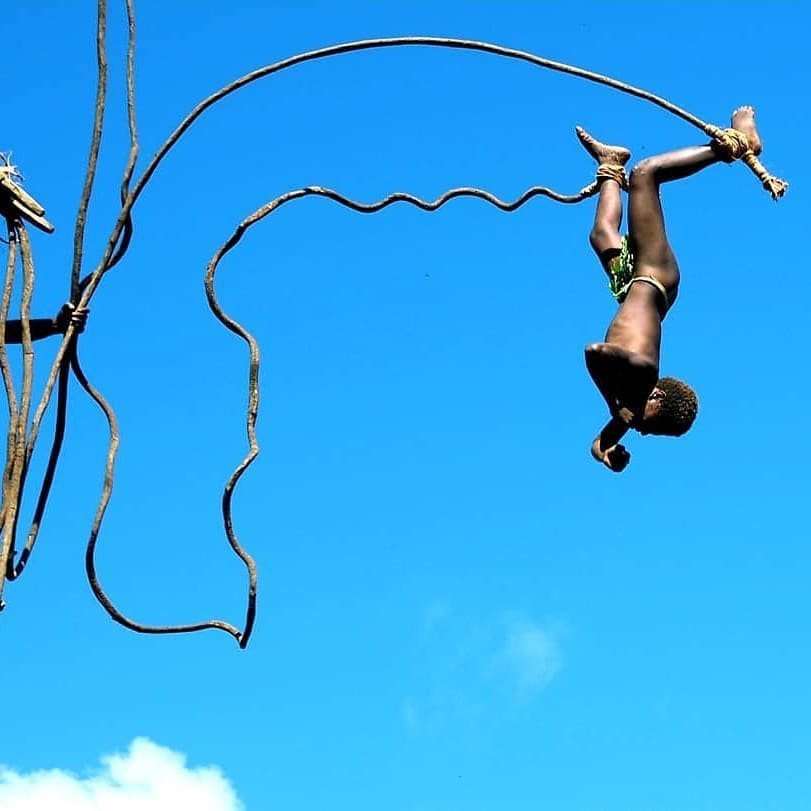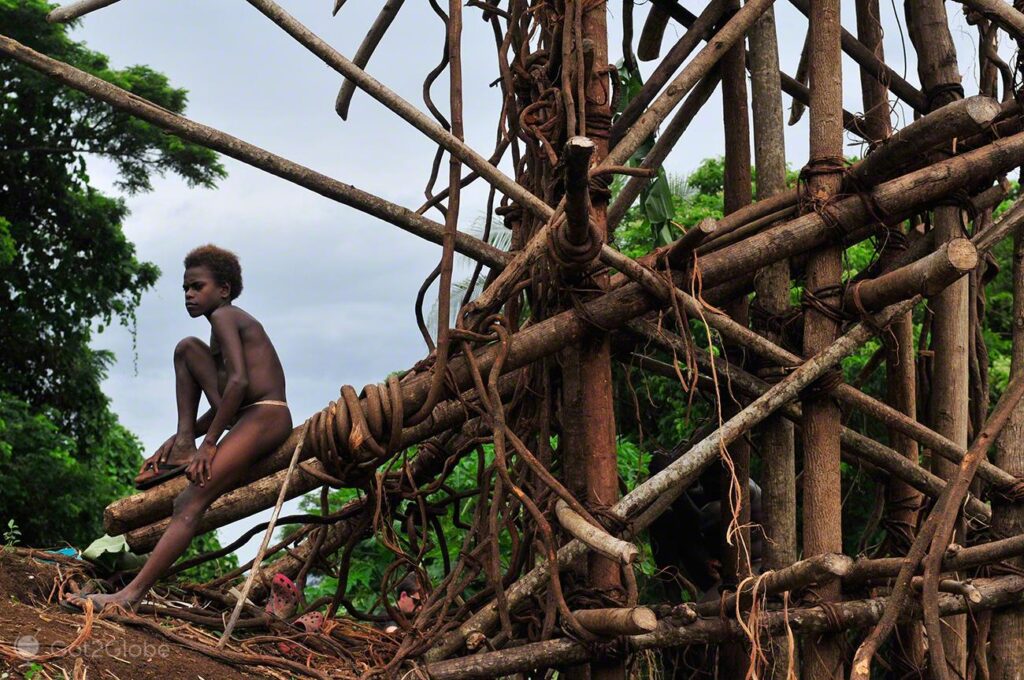Bungee jumping, a thrilling extreme sport that has captured the hearts of adrenaline junkies worldwide, has a fascinating history that dates back to ancient times. In this blog post, we will take a deep dive into the detailed history of bungee jumping, from its prehistoric roots in the Naghol land diving ritual to the birth of modern bungee jumping with David Kirke’s pioneering leap. We will explore how bungee jumping became a global phenomenon and the unsung hero behind it all: the bungee cord. So, buckle up and get ready for an exhilarating ride through the history of bungee jumping.
Prehistoric Roots: The Naghol Land Diving Ritual and Its Cultural Significance
Naghol ritual-land divers
While the modern bungee jumping phenomenon has become a popular adventure sport, the ancient practice of Naghol land diving holds a deeper cultural and spiritual significance for the people of Pentecost Island. The ritual, which is still practiced today, serves as a means of connecting with their ancestors and preserving their cultural heritage.
Interestingly, the Naghol land diving ceremony was not limited to men. Women also participated in the ritual, albeit at a lower height than their male counterparts. This inclusion of women signified the importance of their role in the community and demonstrated their strength and resilience.
“The Naghol land diving ritual is a powerful reminder of the human spirit’s ability to conquer fear and embrace the unknown.”
Land diving
One essential aspect of the Naghol land diving ritual was the construction of the wooden towers. These towers were carefully built by the community, using traditional methods and materials. The construction process was a collaborative effort that brought the community together, fostering a sense of unity and shared purpose. The towers were considered sacred, and their completion was marked by a series of rituals and celebrations.
As part of the land diving ritual, participants adorned themselves with colorful and elaborate costumes, reflecting their connection to nature and their ancestors. The costumes also served as a way for participants to express their individuality and creativity, adding a unique and personal touch to the ceremony.
Another intriguing aspect of the Naghol land diving ritual is the role of music and dance. Traditional songs and dances accompanied the ceremony, providing a rhythmic backdrop to the daring leaps. The music served to heighten the atmosphere and create a sense of anticipation, while the dancers performed intricate moves that showcased their skill and agility.
Over the years, the Naghol land diving ritual has captured the imagination of people worldwide, inspiring the creation of modern bungee jumping. While the two practices differ in many ways, they both embody the human desire to push boundaries and explore the limits of our physical and mental capabilities.

Naghol-Land diving
In conclusion, the Naghol land diving ritual is a powerful reminder of the human spirit’s ability to conquer fear and embrace the unknown. As we continue to explore the history of bungee jumping, let us not forget the rich cultural heritage from which it has evolved and the brave souls who have leaped into the unknown for centuries before us.
David Kirke’s Pioneering Leap: The Catalyst for a Bungee Jumping Revolution
David Kirke’s audacious jump from the Clifton Suspension Bridge not only marked the birth of modern bungee jumping but also set the stage for the sport’s rapid evolution and global expansion. Kirke’s leap was fueled by his innate desire to challenge conventional norms and break free from the shackles of societal expectations. This unquenchable thirst for adventure and adrenaline would soon become the driving force behind the meteoric rise of bungee jumping as a popular extreme sport.
The news of Kirke’s daring feat spread like wildfire, capturing the imagination of adrenaline junkies and thrill-seekers across the globe. As the word spread, enthusiasts began to experiment with various jumping locations, such as bridges, cranes, and even hot air balloons, in their quest to push the limits of human endurance and courage. The sport’s popularity skyrocketed, and it wasn’t long before bungee jumping clubs and commercial operations started to emerge, offering adrenaline-seekers the opportunity to experience the exhilarating free-fall sensation for themselves.
“Life begins at the edge of your comfort zone.” – David Kirke, founder of the Oxford University Dangerous Sports Club and pioneer of modern bungee jumping.
David Kirke’s pioneering spirit and relentless pursuit of adventure served as a catalyst for innovation in the world of bungee jumping. As the sport gained traction, significant advancements were made in the design and manufacture of bungee cords and safety equipment, ensuring a safer and more enjoyable experience for jumpers. This relentless pursuit of innovation has led to the creation of an industry that now offers a wide range of bungee jumping experiences, catering to all levels of thrill-seekers, from first-time jumpers to seasoned adrenaline addicts.
Today, bungee jumping has transcended its humble beginnings and evolved into a global phenomenon, with millions of people across the world taking the plunge each year. From the iconic Kawarau Bridge in New Zealand to the towering Verzasca Dam in Switzerland, bungee jumping has become a must-try activity for adventure enthusiasts and bucket-list chasers alike. The sport’s continued growth and popularity are a testament to the enduring legacy of David Kirke and his pioneering leap of faith, which ignited the spark that would forever change the landscape of extreme sports.
Pushing the Boundaries: The Evolution of Bungee Jumping
David Kirke’s daring leap from the Clifton Suspension Bridge inspired a new generation of thrill-seekers who would go on to push the boundaries of bungee jumping even further. With each new jump, bungee enthusiasts continue to challenge the limits of human courage and ingenuity, ensuring that the sport remains at the cutting edge of adventure and excitement.

Clifton Suspension Bridge
The Rise of Bungee Jumping: A Global Phenomenon
Since David Kirke’s legendary leap, bungee jumping has grown into a worldwide phenomenon, captivating the hearts and minds of thrill-seekers across the globe. Throughout the 1980s, interest in the sport grew exponentially, with more and more people daring to take the plunge. By the 1990s, bungee jumping had earned its place among the pantheon of extreme sports, garnering attention from mainstream media and even inspiring a new generation of adventure seekers.
Commercial bungee jumping sites began springing up all around the world, with an estimated 50 to 65 locations attracting millions of jumpers each year. Bungee jumping’s rapid rise can be partially attributed to the innovative entrepreneurs who saw an opportunity in the sport’s inherent thrill factor. AJ Hackett, a New Zealander known for popularizing the sport globally, contributed greatly to bungee jumping’s growth by opening several commercial jumping sites, including the world’s first permanent bungee platform in Queenstown, New Zealand, in 1988.
As the sport gained popularity, numerous world records were set and broken, further propelling bungee jumping into the spotlight. From the highest commercial bungee jump at the Macau Tower in China to the most jumps in 24 hours, bungee jumping enthusiasts have continuously pushed the limits of what is possible.
Today, the bungee jumping community includes not only adrenaline junkies but also casual thrill-seekers, all looking for that once-in-a-lifetime experience. The sport has evolved over time, with jumps being performed from various structures, such as bridges, cranes, hot air balloons, and even specially designed platforms atop skyscrapers. This diversification has allowed bungee jumping to cater to a wider range of preferences, from those seeking a picturesque backdrop to those wanting an urban adventure.
Beyond the exhilarating experience, bungee jumping has also become a platform for raising awareness and funds for various charitable causes. From events like “Jump for a Cause” to individual bungee jumpers raising money for their chosen charities, the sport has transcended its adrenaline-pumping nature to become a force for good.
In conclusion, bungee jumping’s immense popularity throughout the years is a testament to humanity’s enduring love of adventure, pushing the limits of fear, and testing the boundaries of personal courage. From its ancient roots in the Naghol land diving ritual to the modern-day leaps from towering structures, bungee jumping continues to captivate and inspire individuals across the globe.
Bungee Cord: The Unsung Hero of Bungee Jumping
The bungee cord is the star of this extreme sport, an indispensable component responsible for making bungee jumping a safe and exhilarating experience. The name “bungee” is derived from the elastic cords made of latex rubber that provide the necessary elasticity for the jumps. These cords, the modern equivalent of the vines in the Naghol ritual, allow jumpers to experience the thrill of free-falling without fear of injury or worse. Over the years, bungee cord technology has improved dramatically. The early cords—though revolutionary at the time—were far from perfect and exhibited a tendency to wear out quickly. However, advancements in design and materials transformed bungee cords into a safer and more reliable piece of equipment. Modern cords are manufactured from premium-grade rubber and feature braided polyester sheaths, ensuring a longer lifespan and providing jumpers with the confidence to push their limits.
As bungee jumping grew in popularity, the need for high-quality bungee cords became increasingly important. The evolution of the bungee cord can be traced back to the 1980s, when thrill-seekers began experimenting with various materials to enhance the elasticity and durability of the cords. In response to this demand, manufacturers began developing cords with improved strength and flexibility, allowing jumpers to reach greater heights and experience more intense free-falls.
Today, the bungee cord industry is a thriving business, with numerous companies specializing in the production of cords specifically designed for bungee jumping. These companies are committed to ensuring the safety and satisfaction of jumpers by continually researching and developing new materials and technologies. For instance, some cords now feature a unique multi-strand design, which increases the cord’s elasticity and reduces the risk of snapping. Additionally, many cords are now UV-resistant, making them less prone to degradation from exposure to sunlight.
Another significant development in bungee cord technology is the introduction of harness systems that distribute the jumper’s weight more evenly, reducing the strain on the body during the jump. These innovative harness systems not only enhance the safety of the sport but also allow for a more comfortable and enjoyable experience.
It’s worth noting that the bungee cord’s impact extends beyond the realm of extreme sports. The versatile cords have found applications in various industries, such as transportation, construction, and even space exploration. For example, bungee cords are often used to secure cargo and equipment during transport, and NASA has utilized bungee cords in the development of their space shuttle program.
In conclusion, the bungee cord is a testament to human ingenuity and the relentless pursuit of adrenaline-fueled experiences. This unsung hero of bungee jumping has not only made the sport safer and more accessible but has also played a significant role in shaping the future of adventure sports and other industries. As bungee jumping continues to evolve, one can only imagine the exciting developments that lie ahead for the humble bungee cord.
The Impact of Bungee Jumping on Society and Culture
Beyond the thrilling adrenaline rush it provides, bungee jumping has also had a significant impact on society and culture. As the sport gained popularity, it began to influence various aspects of our lives, from entertainment to fashion and even language.
Television shows and movies have often featured bungee jumping as a way to showcase daring stunts and create memorable scenes. For instance, the 1995 James Bond film “GoldenEye” includes a breathtaking bungee jump sequence from a dam, which helped to further popularize the sport and inspire new enthusiasts.
Moreover, bungee jumping has influenced fashion trends, with sportswear brands incorporating elements of bungee cord designs into their products. This can be seen in the form of bungee-inspired shoelaces, backpack straps, and even clothing fastenings.
The sport has also left its mark on language, with the term “bungee jumping” becoming synonymous with taking risks and embracing new challenges. As a result, the phrase is often used metaphorically in various contexts to encourage people to step out of their comfort zones and face their fears.
Bungee Jumping: A Catalyst for Personal Growth
Many people who have experienced bungee jumping describe it as a transformative and life-changing event. The act of facing one’s fears and taking a literal leap of faith can be incredibly empowering, often leading to personal growth and newfound self-confidence.
Some individuals even use bungee jumping as a form of therapy, helping them overcome personal obstacles and work through emotional challenges. By confronting their fears head-on, they are able to gain a new perspective on life and develop resilience in the face of adversity.
Bungee Jumping and Environmental Awareness
As bungee jumping often takes place in stunning natural settings, the sport has also played a role in raising environmental awareness. Many commercial bungee jumping sites are located in pristine areas, such as forests, mountains, and rivers, which showcase the beauty of our planet and remind us of the importance of preserving these natural wonders.
Furthermore, some bungee jumping operators have adopted eco-friendly practices, such as using solar power to run their facilities and implementing waste reduction measures. These efforts not only help to minimize the environmental impact of the sport but also serve as a reminder of our responsibility to protect the planet for future generations.
Embracing the Future of Bungee Jumping
As bungee jumping continues to evolve, we can expect to see even more innovative and thrilling experiences emerge. From new jumping techniques to advancements in bungee cord technology, the possibilities are endless. Ultimately, bungee jumping remains a testament to human ingenuity, courage, and our innate desire for adventure.
FAQ & Fans Questions
It originated from the Naghol land diving ritual on Pentecost Island in the South Pacific thousands of years ago.
David Kirke performed the first recorded bungee jump in the UK on April 1, 1979, from the Clifton Suspension Bridge in Bristol, using a rudimentary bungee cord set-up made with a harness and buckles from a hang-gliding club.
Bungee jumping became a popular extreme sport in the 1990s, with 50 to 65 bungee jumping sites worldwide, and millions of people having jumped from these commercial operations since the mid-1980s.
“Bungee” comes from “bungee cord,” a type of elastic cord made of latex rubber used for the jumps.

